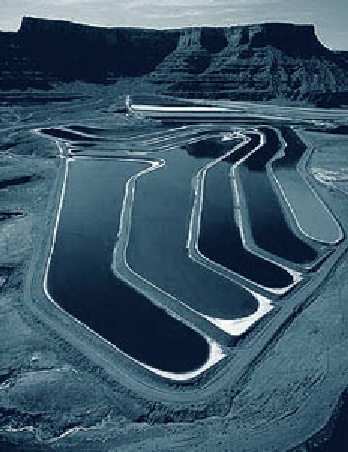Environmental Engineering Reference
In-Depth Information
The main issues of ISL relate
to ensuring that the process
solutions do not migrate beyond
the immediate area of leaching.
The main issues of ISL relate to ensuring that the process solutions do not migrate
beyond the immediate area of leaching.
Solution mining has been used for many decades to extract soluble evaporite salts such
as halite (NaCl), trona (3Na
2
O
4CO
2
), nahcolite (NaHCO
3
), epsomite (MgSO
4
7H
2
O),
carnallite (KMgCl
3
10H
2
O) from buried evaporite deposits
in various parts of the world including the UK, Russia, Germany, Turkey, Thailand, and
the USA. The process is relatively simple, involving the injection of low salinity water with
or without pre-heating, the removal of pregnant solution through extraction wells, and the
recovery of salts by means of evaporation, in the same way that common salt and other salts
are recovered from sea water by the so called solar salt process (
Figure 5.7
). Where there
are difi culties in establishing a connection between injection and recovery bores, a differ-
ent technique can be used, involving concentric pipes, with the solution being pumped up
through the inner pipe. Horizontal bores are commonly used, drilled within horizontal
or gently dipping evaporite strata. Areas where evaporites have previously been mined by
conventional room and pillar underground methods may be further mined by introducing
water which, after contact with pillars in the mine, is pumped out for recovery of the dis-
solved salts.
There are generally no solid wastes from this form of mining. Low volumes of liquid
wastes may be produced which are brines containing salts which are uneconomic to sepa-
rate or for which there is no market. Such liquid wastes are usually re-injected, either into
the same stratum which is being leached or into a separate aquifer.
The main environmental issues associated with solution mining of evaporites relate to
surface or shallow groundwater contamination in and around the evaporation ponds. The
evaporite solutions may be highly corrosive and phyto-toxic. They can react with natural
soil materials used to construct evaporation basins and may migrate to surrounding areas
through seepage, overl ow or windblown spray. These same impacts are common in
solar salt production operations. Surface subsidence including formation of 'sink holes' is
another potential impact after prolonged solution mining, particularly if the solution min-
ing follows underground mining.
6H
2
O), and borax (Na
2
B
4
O
7
FIGURE 5.7
Evaporite Mining in Arizona
Photo Credit:
Jim Wark,
www.airphotona.com










Search WWH ::

Custom Search